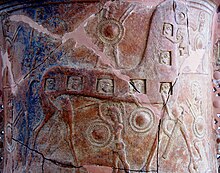This article needs additional citations for verification. (April 2020) |

The Mykonos vase, a pithos, is one of the earliest dated objects (Archaic period, c. 675 BC) to depict the Trojan Horse from Homer's telling of the Fall of Troy during the Trojan War in the Odyssey.[1] It was found in 1961 (with human bones inside) on Mykonos, the Greek island for which it is named, by a local inhabitant. Ìt is on display at the Archaeological Museum of Mykonos. [2]
- ^ Although it is the Iliad that deals with the Trojan War, the epic ends before the fall of Troy, and the story of the Trojan Horse is instead briefly mentioned in the Odyssey.
- ^ Paipetis, S. A (2010). The Unknown Technology in Homer. Springer Science & Business Media. p. 171. ISBN 978-90-481-2514-2.
